Homemade German Bratwurst
This post may contain affiliate links. See my disclosure policy.
Experience the delicious taste of Germany through this thoroughly authentic homemade bratwurst recipe! Make a double batch, freeze them, and you can conveniently grab and grill a bratwurst any time the craving hits you!
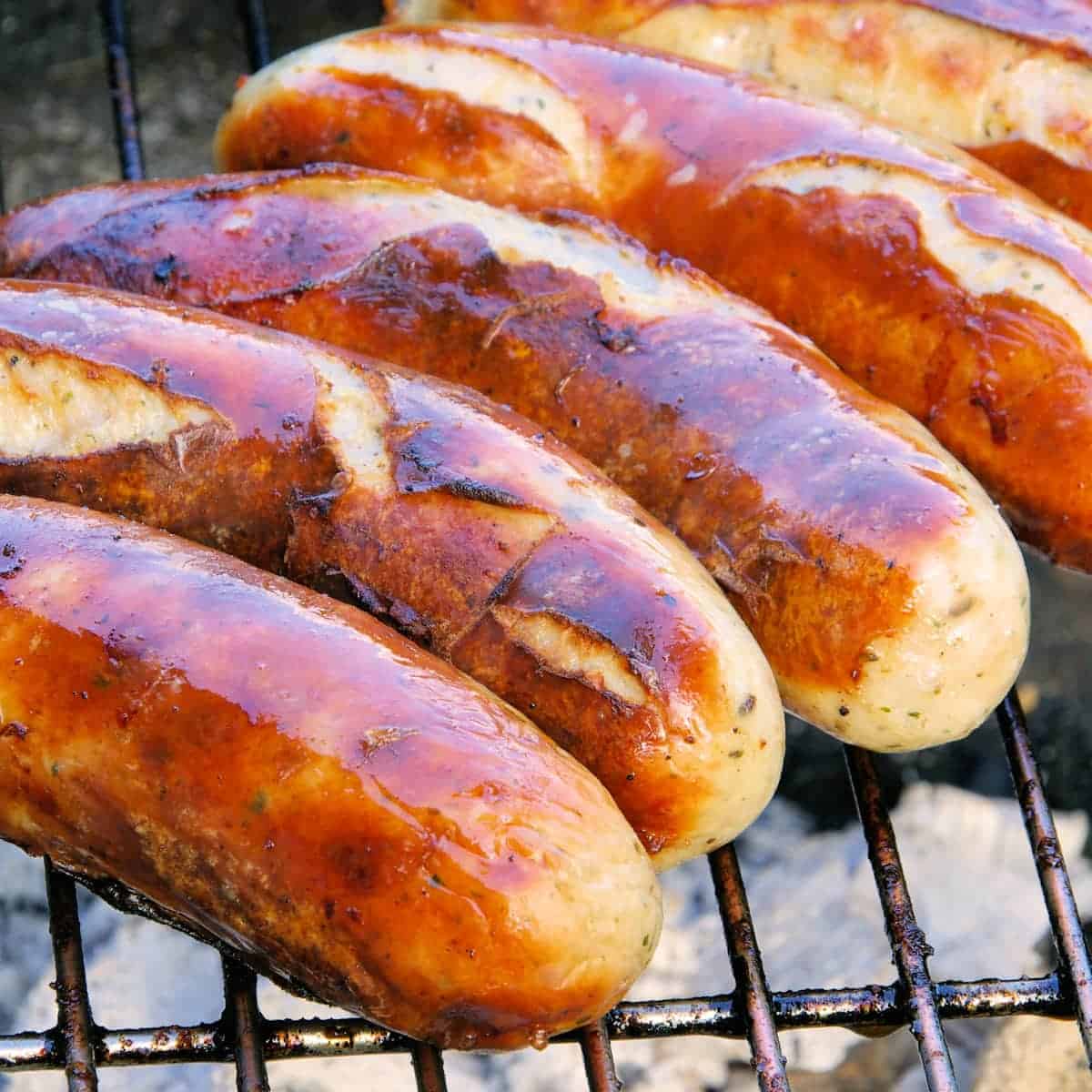
German Bratwurst
This is a special day because today is the day I’m going to show you how to make bratwurst. And not just any bratwurst. I’m going to share with you my recipe for authentic homemade German bratwurst! With the first bite you’ll immediately recognize that “German flavor” that you know and love from time spent in Germany eating Bratwurst from the German fast food stands. Whether enjoyed whole and served with mustard on a crusty roll or sliced and served as Currywurst, there is nothing quite like a real German Bratwurst!
Boasting over 1500 varieties of Wurst, Germany has long been the world’s Sausage Capital. One such Wurst, the Bratwurst, claims around 40 different varieties itself and has a proud heritage going back hundreds of years where it was first officially documented in 1313. Yes, the savory Bratwurst is synonymous with Germany itself and has remained a cultural icon for centuries.
The term Bratwurst is derived from the Old German word Brät (meaning “chopped” meat) as well as the more contemporary verb braten (meaning “to fry”). While some kinds of sausages are eaten poached, the Bratwurst is always grilled or pan-fried to get the skins nice and crispy. However, you can first poach before grilling/frying to infuse them with more flavor (like poaching them in beer) or if you simply want to ensure that they’re evenly cooked through before grilling or frying them.
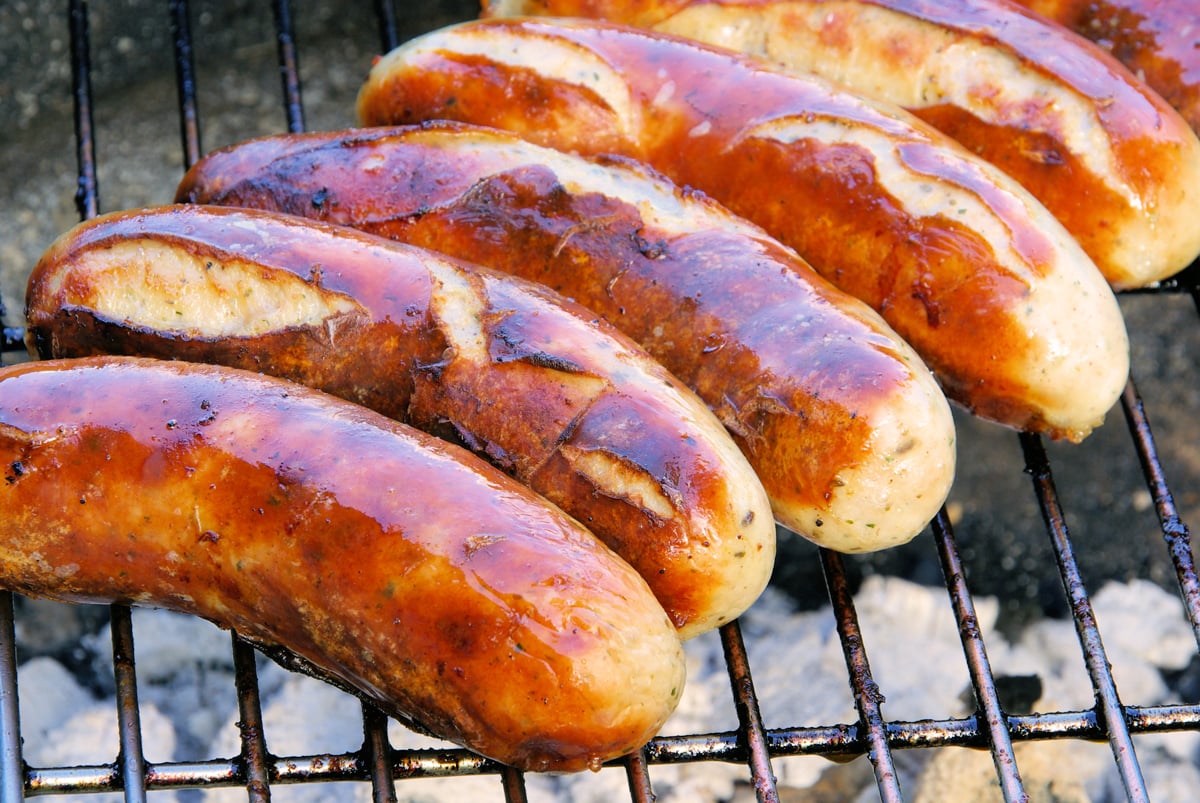
Different regions of Germany make their Bratwursts a little differently and the spices and herbs will vary as well the kind of meat used. Some varieties use pork only, some use a combination of pork and veal, some use mostly veal with a little pork, while others use pork with a little beef.
Some of the most popular regional varieties include the Fränkische Bratwurst, Nürnberger Rostbratwurst, Thüringer Bratwurst (very long and thin, my favorite as a kid) and Rote Wurst (from the Swabia region where I grew up and made with the addition of bacon, yum!).
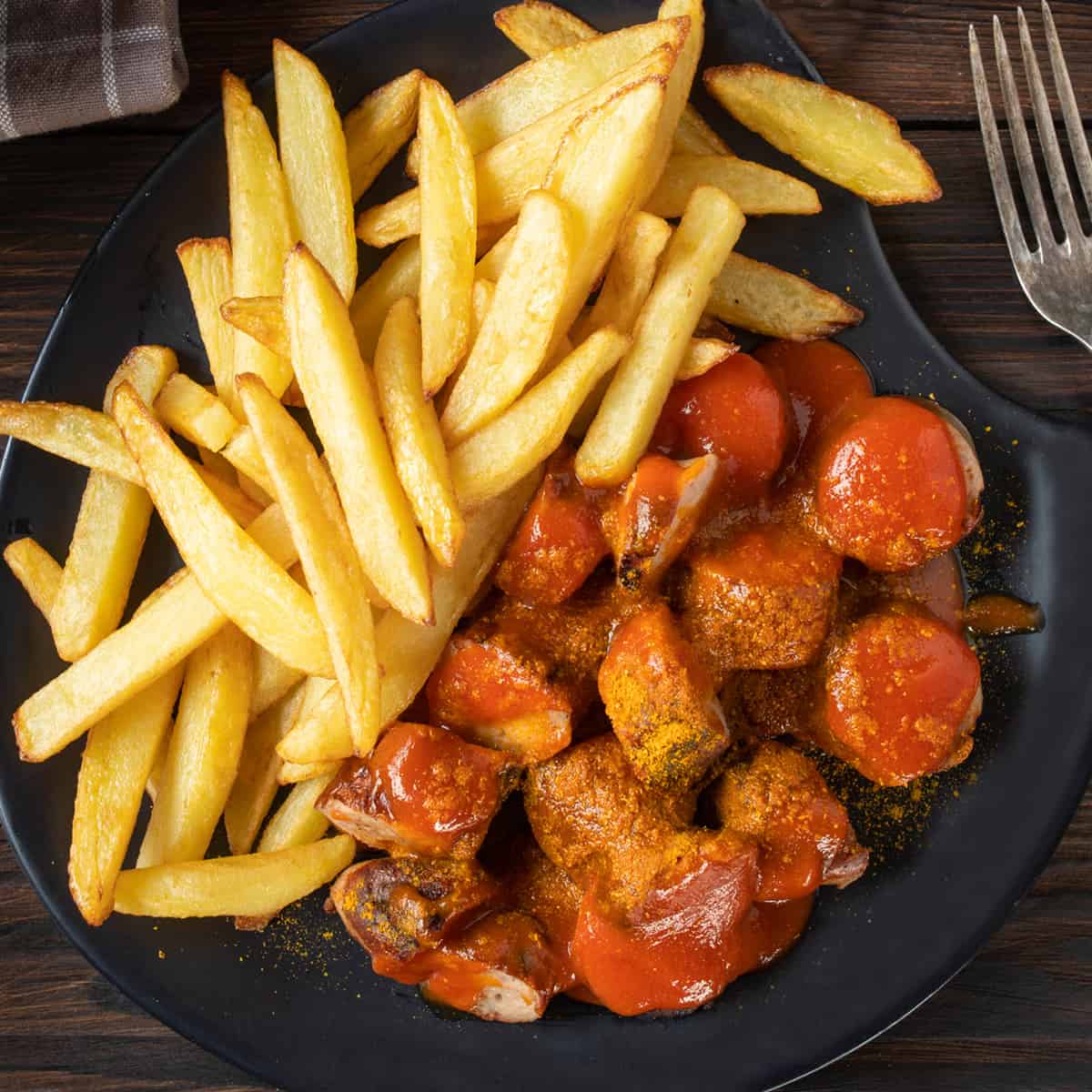
Sausage Making Equipment
For making sausages you’ll need a meat grinder and a sausage stuffer. Years ago I tried using the Kitchenaid attachments for both of these and as any experienced sausage maker will tell you, they’re downright frustrating if you want to make any more than 2 or 3 sausages. If making sausages is something you’re interested in doing I strongly recommend getting some good equipment that won’t leave you frustrated, vowing never to make sausages again, and that won’t jeopardize the quality of your sausages.
In choosing our sausage-making equipment, my husband and I did a lot of research and chose the items that were great quality without having to pay a fortune.
Meat Grinder
I use the STX International Turbo Force Electric Meat Grinder. With 3000 watts, 3 speeds and a 3-year warranty, it has high reviews and comes top recommended by most review sites as the best bang for the buck.
Sausage Stuffer
I also use the Super Deal Heavy Duty 5L Vertical Sausage Stuffer and have been very happy with it. We carefully researched the sausage stuffers on the market and chose this one specifically because of it’s large capacity and 100% metal construction (no plastic parts = not breakable) and it’s also easy to clean.
Hog Casings
I only use casings from The Sausage Maker. They are sourced from North American hogs whereas other brands source them from China. I use and recommend these hog casings from The Sausage Maker.
Sausage Making Books
Once you get the basics of sausage-making down you can experiment with your own flavors and combinations which is what I love to do. But having a few good books with sound instructions for technique and reliable recipes are a must. I have combed through many books on charcuterie and sausage-making over the past few years and these ones continue to be my favorites:
Great Sausage Recipes and Meat Curing by Kutas is a classic and one of the first comprehensive books written on the subject. It’s a no-nonsense, straight-forward book packed full of recipes. Charcuterie: The Craft of Salting, Smoking and Curing by Ruhlman has likewise been a very popular book. The current edition is revised and updated. I have the previous edition and there are inaccuracies and errors in it that the newest edition has reportedly fixed, but I still hear complaints about it. Nevertheless, it’s a great book with some great recipes. Olympia Provisions: Cured Meats and Tales from an American Charcuterie is both a fun and inspiring read. The author, Elias Cairo, is the founder of Olympia Provisions in Portland, Oregon and owns several restaurants and butcher shops there. This book features several of his most popular recipes.
The final two books are both written by Stanley & Adam Marianski: The Art of Making Fermented Sausages and Home Production of Quality Meats and Sausages. While these are a very dry read and don’t have the beautiful photography or inspirational stories the other books have, I consider these indispensable to anyone who is serious about learning the art of charcuterie and sausage-making. Consider them the most comprehensive “how-to” manuals on the market. And if you are planning on dabbling in dry-cured meats, The Art of Making Fermented Sausages is a MUST.
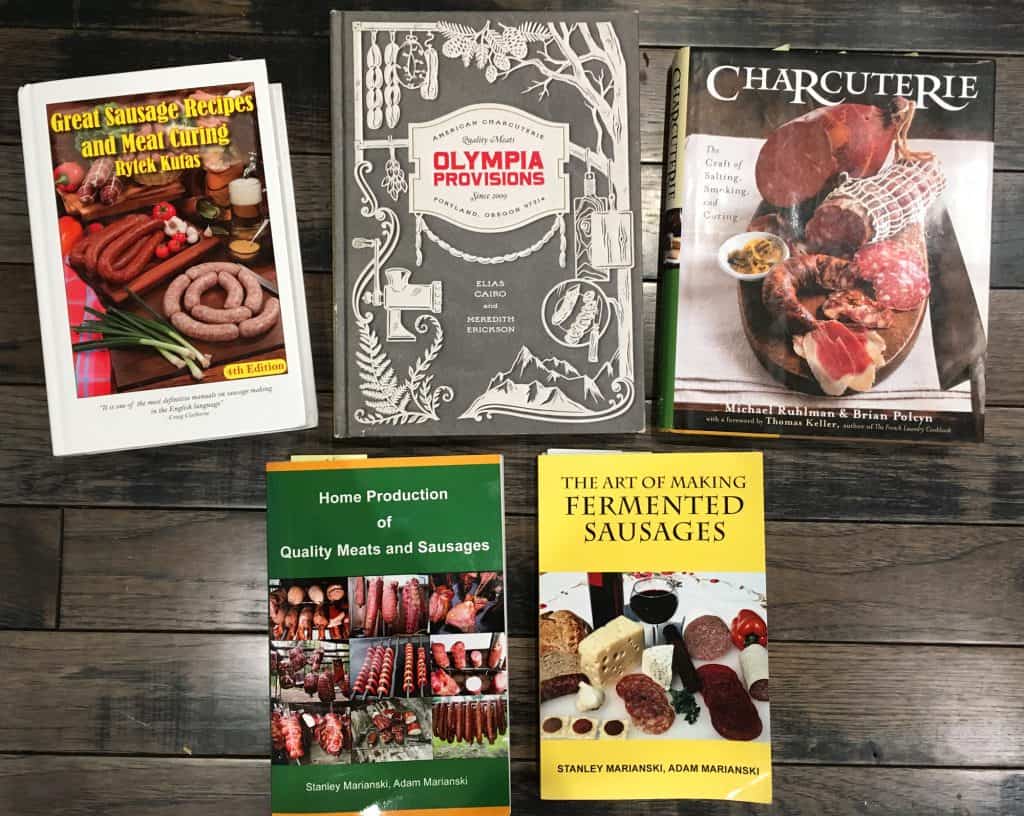
German Bratwurst Recipe
Then let’s get started!
Dice the pork and fat and freeze them for about 45 minutes to get them to a temperature of 32 degrees F (0 celsius).
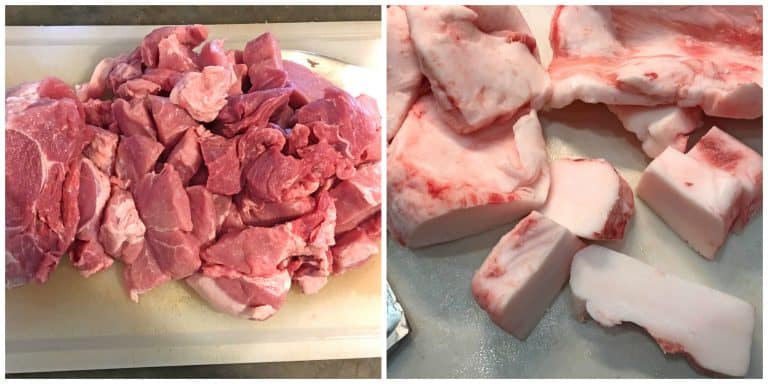
Combine the pork, fat and crushed ice in a bowl and then, working quickly, grind the mixture through a 1/4 inch (6mm) die. Preferably grind the meat mixture into a bowl set atop an ice bath to keep the meat cold. Grind half of the ground mixture a second time. It is imperative that the meat be at a constant cold temperature so that the fat doesn’t get too soft. You should be able to see clear definition between the lean meat the specks of fat in the ground mixture.
Chill the meat in the refrigerator while you assemble the spice mixture.
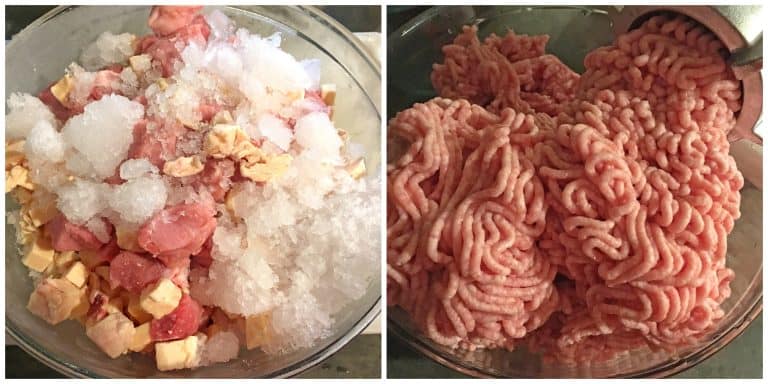
In a small bowl combine all the spices.
Remove the ground meat from the fridge and place it on the stand mixer fitted with a paddle attachment. Add the spice mix and dry milk powder.
Mix the meat mixture with the paddle for 3-4 minutes until threads begin to appear in the meat: If you take a clump of meat and pull it apart with your fingers you will see tiny threads pulling apart. When you see this your meat is ready. If the meat mixture is too dry and stiff, add a little ice water. **If the meat mixture is too dry and stiff, add a little
ice water. You want a soft/smooth mixture that will easily go into the casings.
*This is also the time to taste your sausage mixture so you can adjust the seasonings if needed. To do this, take a bit of the meat mixture, fry it up in a pan, taste it and adjust the seasonings if needed.
Place the meat mixture back in the refrigerator while you prepare the casings.
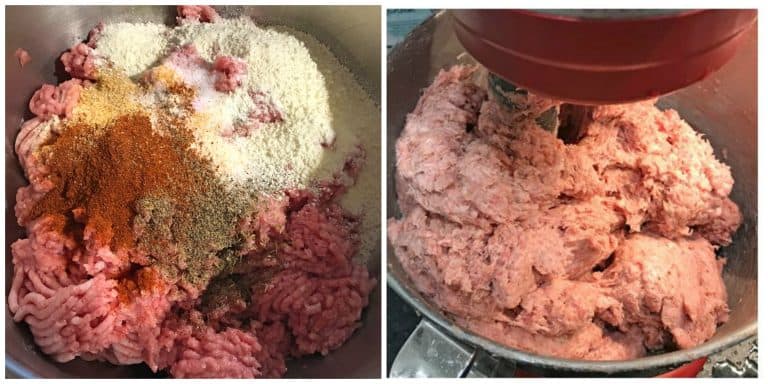
Thread the sausage stuffer with the prepared hog casings, fill the sausage stuffer with the meat mixture, and stuff the casings being careful to avoid air gaps while also being careful to not over-stuff the casings.
Twist the sausages into links. Use a sausage pricker to prick any air bubbles out of the links.
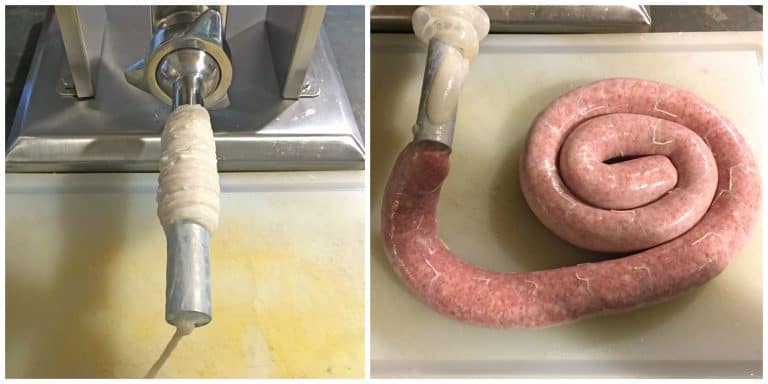
Your Bratwursts are finished. For best results chill the sausages overnight.
To prepare them, you can gently poach them in lightly salted water (optional to ensure they’re evenly cooked or you can poach them in beer to infuse them with more flavor) and then fry or grill them to get their skins nice and crispy. Once poached they will keep in the fridge, tightly wrapped, for up to a week.
You can either freeze the Bratwursts raw prior to poaching (then thaw, poach, fry/grill) or freeze them once they’re poached.
Whether pan-fried or grilled, you’re going to love these Bratwursts!
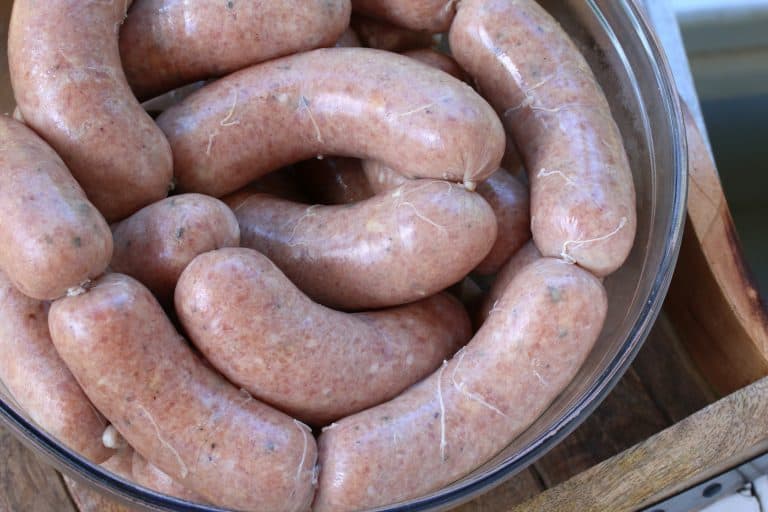
What Do You Serve with Bratwurst?
The most popular accompaniments include a crusty roll cut open and slathered with German mustard or served with sauerkraut, French fries, or potato salad (like this Authentic German Potato Salad).
The Bratwurst is also popularly transformed into the famous Currywurst by slicing the sausages and serving it topped with Curry Ketchup (see our recipe for Currywurst).

For more delicious adventures in homemade charcuterie be sure to try my:
- Smoked Ham Hocks
- Smoked Ham
- Smoked Cheddar Sausages
- Breakfast Sausage
- Bangers
- Mexican Chorizo
- Italian Capicola
- Gravlax
- How to Make Bacon
Save This Recipe
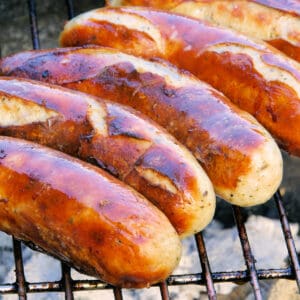
Homemade German Bratwurst
Ingredients
- 2 1/2 pounds boneless pork shoulder (can substitute part veal if desired) , cut into 1/2 inch pieces and put in freezer for 45 minutes prior to grinding
- 12 ounces pork back fat , cut into 1/2 inch chunks and put in freezer for 45 minutes prior to grinding
- 2 cups crushed ice
- For the Spice Mixture:
- 1 1/2 tablespoons salt
- 1/4 cup dried milk powder
- 1 1/2 teaspoons freshly ground white pepper
- 3/4 teaspoon freshly ground black pepper
- 1 teaspoon ground mace (can substitute nutmeg but strongly recommend mace for traditional German flavor)
- 1 teaspoon ground ginger
- 1 teaspoon dried marjoram
- 3/4 teaspoon mustard powder
- 1/4 teaspoon ground cardamom
- 1/4 teaspoon ground coriander
- 1/4 teaspoon crushed caraway seeds
- 32mm natural hog casing , about 4 feet
Instructions
- Combine the pork, fat and crushed ice in a bowl and then, working quickly, use a meat grinder to grind the mixture through a 1/4 inch (6mm) die. Preferably grind the meat mixture into a bowl set atop an ice bath to keep the meat cold. Grind half of the ground mixture a second time. Note: It is imperative that the meat be at a constant cold temperature so that the fat doesn't get too soft. You should be able to see clear definition between the lean meat the specks of fat in the ground mixture.Chill the meat in the refrigerator while you assemble the spice mixture.
- In a small bowl combine all the spices.Remove the ground meat from the fridge and place it on the stand mixer
fitted with a paddle attachment. Add the spice mix and dry milk powder.Mix the meat mixture with the paddle for 3-4 minutes until threads begin to
appear in the meat: If you take a clump of meat and pull it apart with your
fingers you will see tiny threads pulling apart. When you see this your
meat is ready. *If the meat mixture is too dry and stiff, add a little
ice water. You want a soft/smooth mixture that will easily go into the casings.*This is also the time to taste your sausage mixture so you can adjust the
seasonings if needed. To do this, take a bit of the meat mixture, fry it
up in a pan, taste it and adjust the seasonings if needed.Place the meat mixture back in the refrigerator while you prepare the
casings. - Thread your sausage stuffer with the prepared hog casings, fill the sausage stuffer with the meat mixture, and stuff the casings being careful to avoid air gaps while also being careful to not over-stuff the casings.Twist the sausages into links. Use a sausage pricker to prick any air bubbles out of the links.For best results chill the sausages overnight.
- To prepare the bratwursts, you can gently poach them in lightly salted water (place sausages in pot of water, gradually bring liquid to a light simmer/do NOT boil, and poach sausages until partially cooked, 3-4 minutes) and then fry or grill them. Poaching is optional if you want to ensure they're evenly cooked in the middle or if you want to infuse them with more flavor, such as poaching them in beer. Once poached they will keep in the fridge, tightly wrapped, for up to a week.You can either freeze the Bratwursts raw prior to poaching (then thaw, poach, fry/grill) or freeze them once they're poached.This yields roughly 10 bratwursts depending on the size and diameter.
Nutrition
Originally published on The Daring Gourmet July 9, 2019



















hi kimberly,
why do you not use the sausage stuffer attachment that comes with your grinder when making the brats. thanks
Hi Anthony, the dedicated sausage stuffer I use has a much higher capacity and so I’m able to produce more sausages at a time without interruption.
Kimberly, question for you on the Bratwurst.
You show a fat amount and pork shoulder. Is that in addition to the well marbled shoulder? I.e. Increasing the Fat ratio a fair amount.
AGM
Hi Andrew, yes that is correct, that’s 12 additional ounces of fat. Sausages require a generous amount of fat in order to emulsify and be moist and tender, otherwise they will be dry and crumbly.
Happy New Year! Making this recipe today and I was wondering if it’ll taste ok using whole dried milk. I guess I’m about to find out. Thanks for the recipe and I’ll be back to tell you how it tastes.
Happy New Year, Curt! The dried milk serves as a binder and the mechanism in the dried milk that does the binding is the sugar lactose. Non-fat dried milk has a much higher percentage of sugar lactose which is why it is used instead of whole dried milk.
I made this recipe for my very German (grew up in Stuttgart) mother and even she was impressed! She won’t touch American brats or sausages but she asked when we’re making this recipe again
That is a compliment indeed, Jason! :) I completely understand her sentiment and am so glad she enjoyed these – thank you very much for the feedback!
Could i use fresh milk for this instead?
Hi Paige, no, fresh will not produce the same result. Dried milk powder improves the texture and helps retain moisture but it you don’t have it you can omit it.
Thanks Kim, would i need anything else as a binder? Eggs/egg whites for example?
Hi Paige, yes you can add one egg white (not the yolk) which can help with the emulsification of the mixture.
Just made these and doubled the recipe the meat was a bit more than 5 lbs they taste awesome, a bit salty but that’s probably my fault definitely my go to brat recipe thank you for this great recipe
The pork shoulder has a lot of fat on its own. Do I need to remove this and put back 12oz? Please advise
Hi Rene, in order for the Bratwursts to be moist they need a lot of fat. Don’t remove the fat from the pork shoulder, leave it and add the additional 12 ounces. Happy sausage making!
Is is possible to make these without the casing? And if so would you still recommend poaching them before frying/bbqing the brats?
Hi Zion, yes you could simply form them into sausages or patties. I don’t recommend poaching them because without casings they’ll fall apart. Just form them into the shape you want and fry them.
Excellent recipe for these. The spice blend was spot on! Go out and find the dried milk, it makes a big difference! I would like to mention that I feel the poaching step should be better defined, since it is essential not to boil the wursts lest they pop open. One such way is to put them in a pot with cold water, heat on the stove and just before boiling shut it down. Perfect when done. If you wish, check for 70 degrees C (160 degrees F). Thank you
Fantastic, Marvin, I’m thrilled you enjoyed them, thank you for the feedback!
Is the milk powder necessary? I know it is used as a binder but I am wondering if you ever made them without it?
Hi Chris, it helps the sausage retain moisture when it’s cooked and also enhances the flavor. It’s not absolutely necessary and yes, I have made them without it before, but it is a helpful addition.
Absolutely delicious! Wouldn’t, and didn’t, change a thing. These brats took me back many years to the time we were posted to Germany. I enjoyed numerous brats mit brochen (siq) then and haven’t been able to match those brats to anything sold here in Canada, until now. Thank you, thank you for sharing.
Deb, I’m truly thrilled to hear that, thanks so much!
Oh my freaking god, this recipe is so good. I made brat patties just to try it out and was seseriously surprised. They were so good, bold and flavorful. The store bought brats will never be good enough after this.
Fantastic, I’m so glad you enjoyed them, thank you!
Outstanding flavor, just like Weisbaden Germany from the Bratwurst stand where I was stationed back in the 90’s. the only thing I found different was the meat texture, the German ones I had back then was more of a puree or like hotdog meat but snapped off when bitten. Heres to you and yours — Thanks
Thank you, Paul! The texture all comes down to properly mixing/emulsifying the meat mixture and maintaining the right temperature. It’s a skill that takes A LOT of practice to get right.
These are hands down, the best Brats I have ever tasted. I served them to friends from Wisconsin and they couldn’t stop raving about them.
I should have mentioned that I grill my Brats first, for about 25 minutes turning once, then transfer to a beer bath that includes sliced and grated onions, butter, garlic, pepper flakes and a bay leave.
Mark, it’s a beer & onion bath first, and then you mark them on the grill. This will prevent splitting of the casings and allows you to skim off the fat rather than causing flare ups on the charcoal. You are then left with two options – roll it in simmering Secret Stadium Sauce and serve with kraut and/or onions or the brats then go back into the Nesco if you’re hot holding them for a brat fry. – Sconnie born & raised
Thanks so much, Mark, I’m absolutely thrilled to hear that!
Instead of poaching in water use beer and onions then grill and if your doing a large gathering you can put them back in the beer and onions in a warming dish they won’t dry out the flavor is much better cooked this way
Hi can I use venison like elk to make these would I have to and anything else
Hi Tony, you can use venison but since it’s very lean you will need to increase the amount of pork back fat by a few ounces to prevent the brats from being too dry.